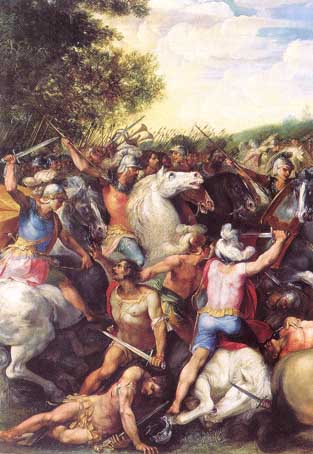Footnotes
- ↑ Dictionary of Greek and Roman Biography and Mythology , William Smith, Editor.
- ↑ Dictionary of Greek and Roman Biography and Mythology , William Smith, Editor.
- ↑ Ogilvie, Commentary, p. 277.
- ↑ Dictionary of Greek and Roman Biography and Mythology , William Smith, Editor.
- ↑ T. Robert S. Broughton, The Magistrates of the Roman Republic (1952).
- ↑ Realencyclopädie der Classischen Altertumswissenschaft .
- ↑ Dictionary of Greek and Roman Biography and Mythology , William Smith, Editor.
- ↑ D.P. Simpson, Cassell's Latin & English Dictionary (1963).
- ↑ Titus Livius, Ab Urbe Condita , ii. 17.
- ↑ Dionysius of Halicarnassus, Romaike Archaiologia, v. 49.
- ↑ T. Robert S. Broughton, The Magistrates of the Roman Republic (1952).
- ↑ Titus Livius, Ab Urbe Condita , ii. 54.
- ↑ Titus Livius, Ab Urbe Condita , iv. 21.
- ↑ Diodorus Siculus, Bibliotheca Historica , xii. 49.
- ↑ Titus Livius, Ab Urbe Condita , vi. 1.
- ↑ Titus Livius, Ab Urbe Condita , ii. 21.
- ↑ Dionysius of Halicarnassus, Romaike Archaiologia, vi. 2.
- ↑ T. Robert S. Broughton, The Magistrates of the Roman Republic (1952), vol. 1 p. 12
- ↑ Titus Livius, Ab Urbe Condita , ii. 28-30
- ↑ Dionysius of Halicarnassus, Romaike Archaiologia, vi. 34, 42, 69.
- ↑ Quintus Asconius Pedianus, in Cornel., p. 76, ed. Orelli.
- ↑ Titus Livius, Ab Urbe Condita , ii. 63
- ↑ Dionysius of Halicarnassus, Romaike Archaiologia, ix. 56.
- ↑ Diodorus Siculus, Bibliotheca Historica , xi. 70.
- ↑ Titus Livius, Ab Urbe Condita , iii. 31.
- ↑ Diodorus Siculus, Bibliotheca Historica , xii. 4.
- ↑ Dionysius of Halicarnassus, Romaike Archaiologia, x. 31.
- ↑ Censorinus, De Die Natali, 17.
- ↑ Dionysius of Halicarnassus, Romaike Archaiologia, x. 40.
- ↑ Titus Livius, Ab Urbe Condita , iii. 65.
- ↑ Dionysius of Halicarnassus, Romaike Archaiologia, xi. 51.
- ↑ Diodorus Siculus, Bibliotheca Historica , xii. 27.
- ↑ Fasti Capitolini .
- ↑ Titus Livius, Ab Urbe Condita , v. 8, 9, 11, 12.
- ↑ T. Robert S. Broughton, The Magistrates of the Roman Republic (1952), vol. 1 p. 83 and note.
- ↑ Titus Livius, Ab Urbe Condita , ii. 41.
- ↑ Dionysius of Halicarnassus, Romaike Archaiologia, viii. 68, ix. 51.
- ↑ Titus Livius, Ab Urbe Condita , ii. 48, 49, iii. 7.
- ↑ Dionysius of Halicarnassus, Romaike Archaiologia, ix. 14.
- ↑ T. Robert S. Broughton, The Magistrates of the Roman Republic (1952).
- ↑ Titus Livius, Ab Urbe Condita , ii. 51.
- ↑ Dionysius of Halicarnassus, Romaike Archaiologia, ix. 25.
- ↑ T. Robert S. Broughton, The Magistrates of the Roman Republic (1952).
- ↑ Livy, Ab urbe condita , ii. 29-30.
- ↑ Titus Livius, Ab Urbe Condita , iii. 11-13.
- ↑ Titus Livius, Ab Urbe Condita , v. 29.
- ↑ Titus Livius, Ab Urbe Condita , x. 23.
- ↑ Titus Livius, Ab Urbe Condita , xxvii. 43.
- ↑ Marcus Tullius Cicero, Brutus , 48.
- ↑ Plutarchus, Lives of the Noble Greeks and Romans , "Sulla," 10.
- ↑ Appianus, Bellum Civile, iv. 48.
- ↑ Publius Cornelius Tacitus, Historiae, iii. 77, iv. 3.
- ↑ Gaius Suetonius Tranquillus, De Claris Rhetoribus, "Persius."
- ↑ Burmann, Praefat. ad. Cic. Herennium. ed. Schütz, p. xiv.
- ↑ Gaius Plinius Caecilius Secundus, Epistulae , vi. 21.
![]() This article incorporates text from a publication now in the public domain : Smith, William, ed. (1870). Dictionary of Greek and Roman Biography and Mythology .
This article incorporates text from a publication now in the public domain : Smith, William, ed. (1870). Dictionary of Greek and Roman Biography and Mythology .{{cite encyclopedia}}: Missing or empty |title= (help)

